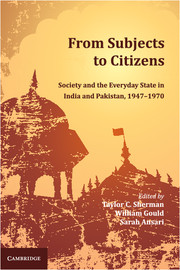Book contents
- Frontmatter
- Contents
- Acknowledgements
- Introduction
- 1 Personal Law and Citizenship in India's Transition to Independence
- 2 From Subjects to Citizens? Rationing, Refugees and the Publicity of Corruption over Independece in UP
- 3 Performing Peace: Gandhi's Assassination as a Critical Moment in the Consolidation of the Nehruvian State
- 4 Migration, Citizenship and Belonging in Hyderabad (Deccan), 1946–1956
- 5 Punjabi Refugees' Rehabilitation and the Indian State: Discourses, Denials and Dissonances
- 6 Sovereignty, Governmentality and Development in Ayub's Pakistan: The Case of Korangi Township
- 7 Everyday Expectations of the State during Pakistan's Early Years: Letters to the Editor, Dawn (Karachi), 1950–1953
- 8 Concrete ‘Progress’: Irrigation, Development and Modernity in Mid-Twentieth Century Sind
- 9 Partition Narratives: Displaced Trauma and Culpability among British Civil Servants in 1940s Punjab
- Contributors
- Index
1 - Personal Law and Citizenship in India's Transition to Independence
Published online by Cambridge University Press: 05 February 2014
- Frontmatter
- Contents
- Acknowledgements
- Introduction
- 1 Personal Law and Citizenship in India's Transition to Independence
- 2 From Subjects to Citizens? Rationing, Refugees and the Publicity of Corruption over Independece in UP
- 3 Performing Peace: Gandhi's Assassination as a Critical Moment in the Consolidation of the Nehruvian State
- 4 Migration, Citizenship and Belonging in Hyderabad (Deccan), 1946–1956
- 5 Punjabi Refugees' Rehabilitation and the Indian State: Discourses, Denials and Dissonances
- 6 Sovereignty, Governmentality and Development in Ayub's Pakistan: The Case of Korangi Township
- 7 Everyday Expectations of the State during Pakistan's Early Years: Letters to the Editor, Dawn (Karachi), 1950–1953
- 8 Concrete ‘Progress’: Irrigation, Development and Modernity in Mid-Twentieth Century Sind
- 9 Partition Narratives: Displaced Trauma and Culpability among British Civil Servants in 1940s Punjab
- Contributors
- Index
Summary
Introduction
The inclusion of a list of Fundamental Rights in the Constitution of 1950 seemed to make real a long-standing Congress promise: that independence from British rule would bring about a dramatic change in the lives of ordinary Indians. Modelling itself on documents such as the French Declaration of the Rights of Man and the American Bill of Rights, the Indian Fundamental Rights set out a vision of the individual citizen-subject, unfettered by notions of gender, religion or caste. The Rights have been seen to mark a profound difference between the nation-state and its colonial predecessor. Underpinning the colonial administration and legal system was an understanding of Indian society as comprising not autonomous individuals but social collectives, defined by caste, gender and religious identity. Indians' relationship with the colonial state was, in the main, mediated through this group identity—access to political office or the law was shaped by a subject's sex and the religious or caste community to which he or she belonged. The passage of the Fundamental Rights suggested a radical reform of this state–society relationship, whereas colonial subjecthood was premised on difference and indirect contact with the state; citizenship suggested a direct relationship between the state and each and every individual Indian.
- Type
- Chapter
- Information
- From Subjects to CitizensSociety and the Everyday State in India and Pakistan, 1947–1970, pp. 10 - 37Publisher: Cambridge University PressPrint publication year: 2014
- 1
- Cited by



